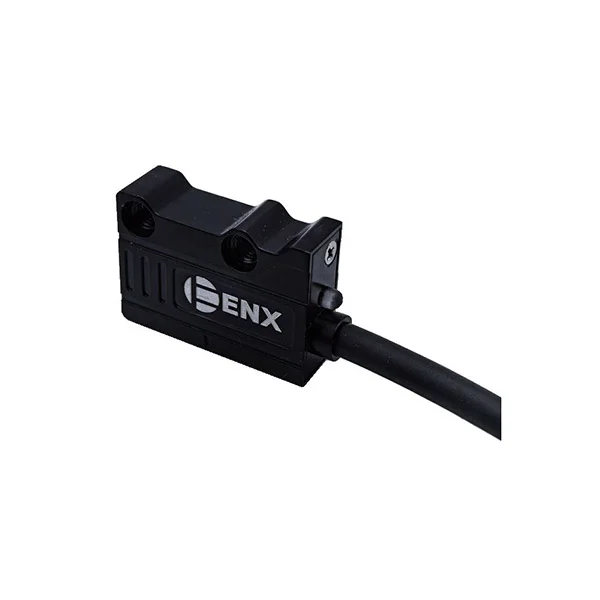- This topic is empty.
-
AuthorPosts
-
2025-08-27 at 2:41 pm #10456
In the field of industrial automation and advanced machinery, the precision magnetic scale linear encoder has become a cornerstone of accurate measurement and positioning. Unlike traditional optical systems, magnetic scale encoders are designed to operate reliably in challenging environments where dust, oil, or vibration may interfere with conventional solutions. In this blog post, ENX Enxiao, a high performance industrial grade encoder manufacturing factory, will share the working principle of precision magnetic scale linear encoder, its applications, etc.
Working Principle of Magnetic Scale Linear Encoder
A magnetic linear encoder operates by reading changes in magnetic fields along a precisely manufactured magnetic scale. The encoder head contains sensors that detect variations in polarity as it moves across the scale, converting these signals into accurate digital or analog outputs.
What sets a precision magnetic scale linear encoder apart is its combination of resolution and robustness. While optical encoders can achieve extreme resolutions, magnetic systems provide an optimal balance of precision and durability in real-world industrial conditions.Why Precision Matters in Linear Encoders
Modern industries—from CNC machining to semiconductor production—demand positioning systems with sub-micron precision. A linear encoder with magnetic scale accuracy enables machine tools to maintain tight tolerances, ensuring consistent product quality. Precision also directly affects productivity; small deviations in measurement can accumulate across production cycles, leading to costly inefficiencies.

Applications of Precision Magnetic Scale Linear Encoders
The application scope of magnetic scale linear encoders is wide-ranging. These devices are integrated into:
-
CNC machines for tool positioning and movement tracking.
-
Robotics to ensure repeatable and precise motion paths.
-
Automated assembly lines where accurate placement reduces waste.
-
Medical imaging systems, where precision ensures reliable diagnostics.
-
Semiconductor wafer inspection tools, requiring nanometer-level accuracy.
In each case, the precision magnetic scale encoder provides the stability needed for industries where errors are not tolerable.
Precision Magnetic Scale Encoders vs. Optical Encoders
When comparing magnetic scale encoders with optical encoders, it becomes clear that each has distinct strengths. Optical encoders often deliver extremely high resolution, but they are sensitive to contamination. A magnetic linear encoder thrives in harsher conditions, offering excellent resilience to dust, moisture, and vibration.
For many industrial sectors, the trade-off leans in favor of magnetic systems, particularly when uptime and environmental resistance are priorities alongside accuracy.Emerging Trends in Magnetic Scale Linear Encoder Development
The global market for precision magnetic scale encoders is evolving rapidly. Several key trends are shaping its trajectory:
-
Miniaturization: Compact encoders designed for robotic joints and micro-automation.
-
Integration with IoT and Industry 4.0: Smart encoders capable of real-time diagnostics and predictive maintenance.
-
Higher resolution magnetic sensing: Bridging the gap with optical encoders.
-
Non-contact designs: Reducing wear and extending operational lifespans.
These innovations highlight how the magnetic scale linear encoder is no longer a niche tool but an integral component of advanced digital manufacturing ecosystems.
Market Relevance of Precision Magnetic Linear Encoders
The demand for high-accuracy magnetic scale linear encoders is expanding across industries like aerospace, automotive, and renewable energy. For instance, in wind turbine systems, encoders play a role in blade pitch control, ensuring efficient energy capture. In electric vehicle production, they support precision machining for critical drivetrain components.
The economic value of accuracy cannot be overstated—companies that invest in precision linear encoder technology gain a competitive advantage through reduced waste, improved output, and enhanced reliability.Challenges in Implementing Magnetic Scale Encoders
Despite their benefits, precision magnetic scale encoders are not without challenges. Calibration must be carefully managed, as errors in alignment can affect accuracy. Additionally, while resistant to environmental contaminants, extreme temperatures or magnetic interference may impact performance.
These challenges, however, are being addressed through advances in materials science, improved shielding methods, and sophisticated signal-processing algorithms.Future Outlook of Precision Magnetic Scale Linear Encoder Technology
Looking ahead, the role of precision magnetic scale encoders will only grow. As automation technologies expand into new fields—such as biomedical devices, space exploration, and advanced additive manufacturing—the need for reliable, resilient, and accurate measurement systems will intensify.
Manufacturers are likely to focus on hybrid solutions that combine magnetic and optical sensing to deliver the best of both worlds: precision, durability, and adaptability.Conclusion
The precision magnetic scale linear encoder represents a critical link between mechanical movement and digital control. By translating motion into highly accurate signals, it enables industries to push the boundaries of what is possible in manufacturing, robotics, and high-tech innovation.
As the world moves deeper into the era of smart factories and Industry 4.0, these encoders will not only ensure precision but also act as enablers of connectivity, reliability, and efficiency. Investing in precision magnetic scale encoder technology today means preparing for a future where accuracy and innovation walk hand in hand.http://www.enxsensors.com
ENX Enxiao -
-
AuthorPosts
- You must be logged in to reply to this topic.